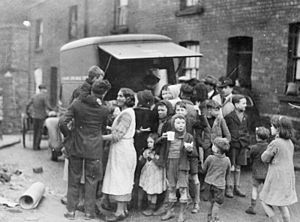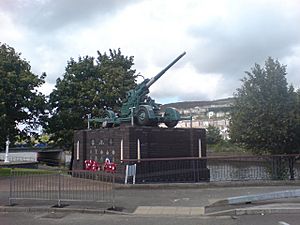Swansea Blitz facts for kids
Quick facts for kids Swansea Blitz |
|||||
|---|---|---|---|---|---|
| Part of the Strategic bombing campaign of World War II | |||||
 Mothers and children in a working-class area of Swansea have tea and sandwiches from a mobile canteen after a night's bombing (Photo: Imperial War Museums) |
|||||
|
|||||
| Belligerents | |||||
| Casualties and losses | |||||
| Unknown | 230 killed, 397 injured | ||||
The Swansea Blitz was a time when the German air force, called the Luftwaffe, heavily bombed the city of Swansea during World War II. This happened for three nights, from February 19 to 21, 1941. During these attacks, 230 people sadly lost their lives, and 397 were injured. Germany targeted Swansea because it was a very important port city. Its docks and nearby oil refinery were key for Britain. Destroying these places was part of Germany's plan to weaken Britain's war efforts. They also hoped to lower the spirits of people and emergency workers.
Contents
Preparing for Air Raids: How Swansea Got Ready
After the Air Raid Precaution Act of 1937 was passed, Swansea Council had to protect its 167,000 residents. They planned to build public air raid shelters. They also set up rescue teams and fire services. As the threat of war with Germany grew, Swansea council built over 500 public shelters. They also gave out Anderson shelters for people's homes.
When the war started in September 1939, more shelters were built quickly. The council also used cellars and basements as temporary shelters. Many people with gardens built Anderson shelters to stay safe. But not everyone had a garden, so some used crowded public shelters. Later, in 1940, Morrison shelters were introduced. These were like strong steel tables people could hide under inside their homes. Some families even went to nearby countryside areas every night. They slept in tents, cars, or on the beach to escape the bombs.
Bombing Attacks: What Happened During the Blitz
First Attack: June 1940
The first air raid on Swansea happened early on June 27, 1940. A German plane dropped a marker flare first. Then, other bombers dropped powerful bombs in the Danygraig area, east of the city. This raid was not very heavy. No one was reported hurt. Some unexploded bombs were found near Kilvey Hill.
The Three Nights' Blitz: February 1941
Throughout 1940, Swansea faced attacks from single or small groups of German bombers. There were also a few small raids in January 1941. But the worst bombing happened over three nights in February 1941. These nights, February 19, 20, and 21, became known as the Three Nights' Blitz. It began at 7:30 PM on February 19.
On the first night, a bomb hit the building where the main anti-aircraft gun control was located. Two officers and five other soldiers were killed or badly hurt. But the guns kept firing under local control. Communications also stayed working.
On the evening of February 21, there was confusion between air control centers. This caused the anti-aircraft guns to stop firing for almost an hour. No fighter planes arrived either. This left the city center unprotected. After the guns started firing again, some enemy planes were shot down. But the center of Swansea was already badly damaged. Fires and delayed-action bombs destroyed many communication lines.
When the "all clear" siren finally sounded after three days, much of Brynhyfryd, Townhill, and Manselton was destroyed. A total of 230 people had died, and 409 were injured. Also, 7,000 people lost their homes. The city center was hit directly, causing huge fires. Many shops, including the Ben Evans department store and the old Victorian market, were ruined.
Over the three nights, enemy planes were active for nearly 14 hours. It's thought that 1,273 high explosive bombs and 56,000 incendiary bombs (fire bombs) were dropped. An area of about 41 acres was targeted. 857 buildings were destroyed, and 11,000 were damaged. To boost people's spirits after the blitz, King George VI and Queen Elizabeth, along with Prime Minister Winston Churchill, visited Swansea.
More Bombing Attacks
Swansea was attacked several more times after the main blitz. The last recorded raid happened on February 16, 1943.
Grammar School Hit
The old grammar school on Mount Pleasant Hill was built in 1851. Famous people like Dylan Thomas and Roy Jenkins went there. It took a direct hit and was badly damaged. However, the science labs, gym, and workshops survived. Teaching for older boys soon started again in the headmaster's house. Younger boys moved to a nearby empty school building. This quick plan helped avoid too much disruption to their education until 1949. The headmaster, J. Gray Morgan, worked hard to make this happen.


